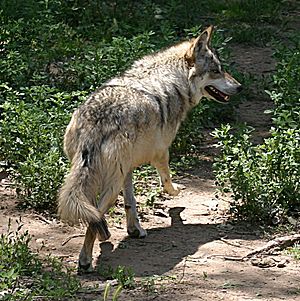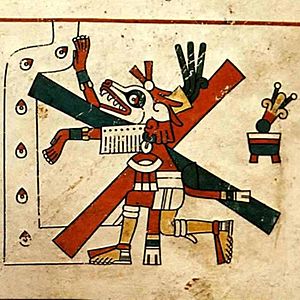Mexican Wolf facts for kids
Quick facts for kids Mexican Gray Wolf |
|
|---|---|
 |
|
| Wolf at the Rio Grande Zoo showing its back and hind coloring | |
| Conservation status | |
| Scientific classification | |
| Kingdom: | |
| Phylum: | |
| Class: | |
| Order: | |
| Family: | |
| Genus: | |
| Species: | |
| Subspecies: |
C. l. baileyi
|
| Trinomial name | |
| Canis lupus baileyi (Nelson & Goldman, 1929)
|
|
The Mexican wolf (Canis lupus baileyi), also known as the lobo, is a type of gray wolf. It used to live in places like southeastern Arizona, southern New Mexico, western Texas, and northern Mexico.
This wolf is the smallest gray wolf in North America. It looks a bit like the Great Plains wolf, but it has a smaller, narrower skull. Its fur is darker, often yellowish-gray with lots of black on its back and tail. Scientists believe its ancestors were the first gray wolves to come to North America after the Beringian wolf died out. This is because of where they lived and their unique features.
Contents
Where Do Mexican Wolves Live?
Mexican wolves once lived in southeastern Arizona, southwestern New Mexico, and parts of western Texas in the USA. They also lived in the Sierra Madre Occidental mountains in Mexico. This area is known for its Madrean pine–oak woodlands, which is a type of forest.
This habitat is perfect for the Mexican wolf because it's where their main food source lives: the Coues’ white-tailed deer. In 2017, there were at least 143 Mexican wolves living freely in Mexico, Arizona, and New Mexico. There were also 240 wolves in special breeding programs to help their numbers grow.
A Brief History of the Mexican Wolf
In ancient Mexico, before Europeans arrived, the Mexican wolf was very important. People saw it as a symbol of war and the Sun. In the city of Teotihuacan, people would breed Mexican wolves with dogs. This created strong, loyal guard animals.
Wolves were also part of religious ceremonies. Their heads were sometimes kept by priests and warriors as special clothing. Other body parts were placed in underground burial rooms, pointing west. This direction was important because it symbolized new life, the Sun, and the underworld, and was linked to the dog-like god Xolotl.
The first written record of the Mexican wolf was in 1780. A writer named Francisco Javier Clavijero called it Cuetzlachcojotl. He said it was like a coyote but had thicker fur and a neck more like a wolf.

Why Did Mexican Wolf Numbers Drop?
The number of Mexican wolves in the Southwestern United States quickly dropped between 1915 and 1920. By the mid-1920s, wolves rarely caused problems for livestock in areas where they once caused millions of dollars in losses.
A scientist named Vernon Orlando Bailey wrote in the 1930s that the most Mexican wolves lived in the open grazing areas of the Gila National Forest. He also noted that wolves were completely gone from the lower Sonoran Desert. He thought there were 103 Mexican wolves in New Mexico in 1917, but only 45 a year later. By 1927, it seemed they had disappeared from New Mexico.
Some wolves still entered Texas, New Mexico, and Arizona from Mexico until the 1950s. But they were also hunted using traps, poison, and guns. The last wild wolves killed in Texas were in December 1970. Wolves were still reported in small numbers in Arizona in the early 1970s. It's hard to know for sure when the very last wolf was killed in New Mexico, as some reports might have been about other animals.
Mexican wolves lasted longer in Mexico. This was because human settlements, ranching, and wolf hunting started later there. However, wolf numbers began to fall quickly in the 1930s and 1940s. Mexican ranchers started using the same methods as American ranchers, often using a strong poison called 1080.
Images for kids
-
A pair of Mexican wolves with their pups at a special facility in Socorro, New Mexico
See also
 In Spanish: Lobo mexicano para niños
In Spanish: Lobo mexicano para niños





